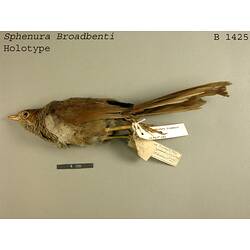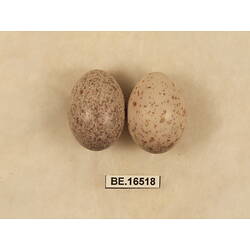General Description
Body dark greyish-brown, off-white breast with obvious brown scalloped pattern. Throat and face in front of and around eyes off-white with top of head rufous (reddish). Eyes red. Legs and feet brown to grey-brown. Tail long. Body up to 27.5 cm long.
Biology
Rufous Bristlebirds are poor flyers and are usually found only on the ground. They are normally seen on their own but occasionally in pairs. When disturbed a Rufous Bristlebird will run away quickly with its tail held up. They breed between August and January, laying two eggs in dome-shaped nests. These nests are made from grass and twigs and are built close to the ground, often in tussocks or low shrubs. Rufous Bristlebirds forage mostly on the ground, where they feed on invertebrates, fruits and seeds. Currently, there are two subspecies of Rufous Bristlebird (Dasyornis broadbenti broadbenti and D. broadbenti caryochrous) which are both threatened, largely due to habitat loss. A third subspecies (D. broadbenti litoralis) is believed extinct as it has not been recorded since 1906. Dasyornis broadbenti caryochrous only lives in Victoria in the Otways region.
Distribution
Southeast mainland Australia within 40km of the coast; between the mouth of the Murray River (South Australia) and Anglesea (Victoria).
Habitat
Coastal scrubland, heathland and forest, particularly in grass, thickets and shrubs.
More Information
-
Animal Type
-
Animal SubType
-
Brief Id
Medium-sized red-brown bird with reddish head, off-white scalloped throat and long tail.
-
Colours
Rufous, Grey-brown, Grey, Brown
-
Maximum Size
27.5 cm
-
Habitats
-
When Active
Diurnal
-
Diet
Omnivore
-
Diet Categories
Invertebrates, Fruit, Seeds
-
Endemicity
-
Commercial
No
-
Conservation Statuses
CITES: Trade restrictions (Appendix II), FFG Threatened List: Vulnerable, EPBC Act 1999: Not listed, IUCN Red List: Least Concern
-
Taxon Name
-
Scientific Author
(McCoy, 1867)
-
Common Name
Rufous Bristlebird
-
Kingdom
-
Phylum
-
Subphylum
-
Class
-
Order
-
Family
-
Genus
-
Subgenus
-
Species Name
broadbenti






